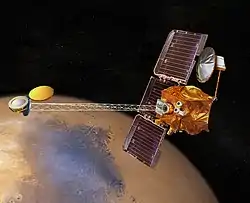Mars 1M No.1
Mars 1M No.1, designated Mars 1960A by NASA analysts and dubbed Marsnik 1 by the Western media, was the first spacecraft launched as part of the Soviet Union's Mars programme.[1] A Mars 1M spacecraft, it was intended for conducting flight testing system and to study the interplanetary environment between Earth and Mars, however it was lost in a launch failure before it could begin its mission.[2][3]
 A Mars 1M spacecraft | |
| Names | Marsnik-1, Korabl-4, Mars 1960A |
|---|---|
| Mission type | Mars flyby |
| Mission duration | Failed to orbit |
| Spacecraft properties | |
| Spacecraft type | Mars 1M |
| Manufacturer | OKB-1 RSC-Energia |
| Launch mass | 650 kilograms (1,430 lb) |
| Start of mission | |
| Launch date | 10 October 1960, 14:27:49 UTC |
| Rocket | Molniya 8K78/L1-4M Modified SS-6 |
| Launch site | Baikonur 1/5 |
| Instruments | |
| 1) Ultraviolet Spectrograph
2) Radiation Detector 3) Cosmic-Ray Detector 4) Television Imaging System (Removed) 5) Spectroreflectometer (Removed) | |
Launch
Mars 1M No.1 was the payload of the Molniya 8K78 rocket's maiden flight. The rocket, which had serial number L1-4M, was a new derivative of the R-7 series, with a Blok-I third stage replacing the Blok-E used on the Vostok, and a new Blok-L fourth stage. The vehicle lifted off from Site 1/5 at the Baikonur Cosmodrome at 14:27:49 UTC on 10 October 1960.[4][5]
Scientific Instruments[6]
- Ultraviolet Spectrometer
- Radiation Detector
- Cosmic-Ray Detector
- Television Imaging System (Removed)
- Spectroreflectometer (Removed)
Television Imaging System and Spectroreflectometer were removed due to mass constraints.
End of mission
It was determined that during the course of second stage of flight, the resonant vibration in third stage of rocket provoked by malfunction of gyroscope and it damaged the attitude control system of carrier rocket. Following this issue, the horizon sensor disconnected from the booster and the rocket descended from normal flight path angle. As a consequence the rocket's third stage commanded to stop ignition after five minutes into flight, during this stage the spacecraft uplifted to an altitude of 120 km before re-entry. Thereafter, the spacecraft re-entered and disintegrated in LEO and its debris fallen over Siberia with 4,800 km down range. It failed to achieve low earth orbit.[7][8]
See also
References
- Zak, Anatoly. "Russia's unmanned missions to Mars". RussianSpaceWeb. Retrieved 26 October 2013.
- Krebs, Gunter. "Mars 1M". Gunter's Space Page. Retrieved 26 October 2013.
- Wade, Mark. "Mars 1M". Encyclopedia Astronautica. Retrieved 26 July 2019.
- McDowelll, Jonathan. "Launch Log". Jonathan's Space Page. Retrieved 26 October 2013.
- "(PDF) Chronology of Mars Missions". ResearchGate. Retrieved 2018-12-09.
- "In Depth | 1M/1". Solar System Exploration: NASA Science. Retrieved 2018-12-09.
- "The Space Review: The beginnings of planetary exploration: the first probes to Venus". www.thespacereview.com. Retrieved 2018-12-09.
- "Mars 1M satellite". weebau.com. Retrieved 2018-12-09.

.jpg.webp)
.jpg.webp)